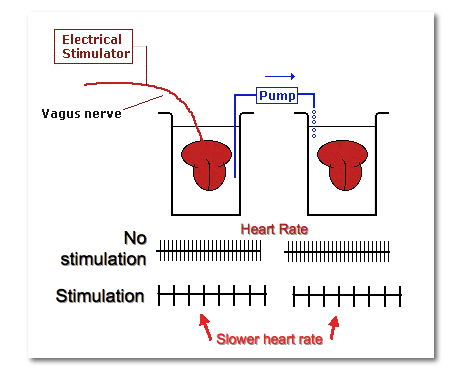January 25, 2025
![[Brain Image]](../graphics/head_space.gif)
PSY 340 Brain and Behavior
Class 07: The Concept of the Synapse & Chemical Events at the Synapse (pt. 1) OUTLINE
|
January 25, 2025 |
PSY 340 Brain and Behavior Class 07: The Concept of the Synapse & Chemical Events at the Synapse (pt. 1) OUTLINE |
|
| |
||
Why is an action potential slower in a thin vs. a thick axon?
The interior of an axon is filled with all sorts of proteins and other molecules doing various jobs (e.g., transporting neurotransmitters from the soma to the terminal buttons and vice-versa). Thick axons provide fewer "obstacles" (other proteins and molecules) to Na+ ions as the move into the axon.
The Puzzle of How Neurons Are Connected
Ramon y Cajal
Sir Charles Scott Sherrington (1857-1952) & the Discovery of the Synapse
Reflexes: automatic muscle responses to stimuli
- Sensory neuron --> interneuron ("intrinsic") neuron --> motor neuron at level of the spinal cord = reflex arc
- reflexes are slower than simple conduction along an axon would suggest.
- weak stimuli presented at different times or in different locations elicit a stronger response than a single strong stimulus does.
- excitation of one muscle set leads to relaxation in its opposing muscle set.
Speed of Reflex & Delayed Transmission at the Synapse
- 15 meters/sec (found) versus 40 meters/sec (expected)
- Sherrington reasoned that the delay in neural transmission in a reflex occurred because it took time for the signal to cross between neurons. It takes about 0.5 mSec (1/2000 of a second) for a signal to cross. So, there must be a gap there.
- Sherrington labeled the gap a synapse
- Awarded the Nobel Prize for Medicine & Physiology in 1932.
Summation: The effects of different kinds of stimulation on a neuron's tendency to fire
Two types: temporal and spatial
Temporal summation: multiple firings at the same time
- Sir John Eccles (1903-1997) showed temporal summation in single cells.
- Won the Nobel Prize in 1963 for his work on how inhibitory and excitatory processes occur at the synapse.
Spatial summation: multiple firings in different places
EPSPs and IPSPs: Effects at the Synapse
- Excitatory Post-Synaptic Potential (EPSP) = postsynaptic neuron becomes more likely to fire
- Inhibitory Post-Synaptic Potential (IPSP) = postsynaptic neuron becomes less likely to fire
- Spontaneous firing rate = many neurons actually spontaneously, e.g., 10-20 times per second. Why?
- One recent hypothesis argues that the brain & its neurons ought to be considered a dynamic organ which is constantly active even in the absence of stimulation.
- Another suggestion attribute this firing to the brain's continual effort to predict what it is experiencing and to refine the models that it uses to make these predictions
- The specific neurochemical factors contributing to spontaneous firing are quite complex.
Chemical Events at the Synapse (pt. 1)
Otto Loewi (1873-1961) & Chemical Transmission at Synapses (1920)
• adrenaline (epinephrine) causes the heart to beat faster, relaxes the stomach muscles, dilates the pupils.
• sympathetic nervous system (SNS)
• Otto Loewi in 1920
• Stimulated the vagus nerve
• Vagusstoff which was actually....Acetylcholine (ACh)

Chemical Activity at the Synapse
This first version of this page was posted January 30, 2005